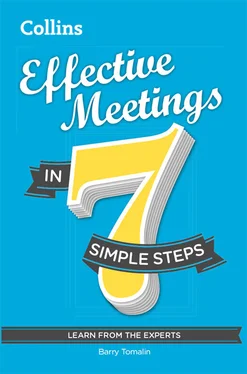Cabaret layouts work well for meetings where there are 12 or more participants, and they are seated around tables for three or four, a bit like tables in a nightclub – hence the name cabaret. A cabaret layout allows for lots of group work and reporting back.
For large groups, sitting in rows might be the best way to proceed. It’s difficult to have group discussion in a theatre layout though. It’s best for listening to a presentation and asking and answering questions afterwards (Q&A).
Avoid this one if you can. It promotes opposition, as mentioned earlier. The British parliamentary system is based on government versus opposition. So it’s noisy and, in a fairly friendly British way, antagonistic.
The same occurs in business, but it’s not always friendly. Sometimes, this layout is dictated by the shape of the room and the number of attendees. The danger is that if people are opposite each other, they will naturally sit with those they agree with and opposite those they don’t.
As an example: a firm had contractual difficulties with one of its affiliates. A meeting was arranged to try to resolve the problem. Unfortunately, the meeting room had a table with two rows of chairs facing each other. The contractor and her team sat on one side and the affiliate and his team on the other. The atmosphere was stiff and cold. Points of agreement were difficult to find.
Then the contractor had a brainwave. She suggested they take a break, and during the break she changed the meeting room. The new room had a round table! Immediately, there was a more positive atmosphere, and after more discussion both sides reached an agreement.
What had changed? The meeting leader was convinced of one thing. Sitting round a table in a circle diminished the atmosphere of confrontation and increased the willingness to cooperate.
As a final thought, have you ever watched The Apprentice ? Think what you’ve learned about meeting organisation and room layout – how does it apply to what you’ve seen on the show? At first, it’s lovey dovey. Lord Sugar arrives in his Bentley. He stands in front of the teams, mixes them up and gives them the task. Fifty minutes later, it’s another story. He sits at a desk in front of a frosted glass door, flanked by his cohorts. Opposite him in two rows sit or stand the two teams. There aren’t enough seats for everyone.
It’s a mixture of theatre style, in this case more like a classroom, and facing rows. The two teams aren’t actually facing each other, but it feels very oppositional – almost like a courtroom. The layout seems designed for maximum superiority (Lord Sugar) and maximum humiliation (the contestants).
This is nothing to do with Lord Sugar, but everything to do with the production values which, Big Brother style, try to create tension and conflict in order to build audiences. The age of the gladiator is not dead! But it’s exactly the wrong way to set up and run a meeting.
Imagine if the approach was cooperative and aimed at showing everyone at their best. People would sit next to, not opposite each other. They would discuss in a circle, a horseshoe or cabaret style, not in facing rows. Lord Sugar and his cohorts would sit among the contestants, not apart from them.
Layout determines whether the atmosphere will be collaborative or confrontational.
So let’s imagine you are asked to organise a meeting. What? No! That’ll never happen to you! Well, actually it might. An intern was asked to organise the weekly management meeting. Why? It was a good way to test her organising skills and her willingness to take responsibility and use her initiative. She came through with flying colours and, as a result of this and her other work, got an offer of a permanent job.
What did she do? She used the framework. Five W’ s and an H :
WHY? First she asked why the meeting was necessary. What was it intended to achieve?
WHAT? Then she checked the topic. That would go on the invitation.
WHO? Then she asked who needed to be invited, names and job titles. She double-checked these. (Her life would have been a misery if she had got them wrong!)
WHEN? Her line manager suggested a time, but she needed to check alternatives. She used a time chart to check everyone’s availability and found a date and time that suited everyone.
WHERE? She had to decide whether to hold the meeting in the office or outside the office. In the event, her line manager preferred the office. So she booked a room, checked it, moved the tables and chairs around, ensured there was a data projector and booked tea, coffee, biscuits and a sandwich lunch from the canteen.
HOW? What needs to happen?
Having decided on the Why, What, Who, When and Where , the intern finally had to deal with the How . What did she need to do?
1Book a room.
2Send out the invitations.
3Chase up anyone who hadn’t replied.
4Circulate the agenda and any papers to be ‘tabled’ (discussed).
5Chase up anybody who hadn’t replied (there’ll always be a few).
6Check the room was OK for the meeting. Raid the stationery cupboard (for any pens/paper the participants will need).
7Telephone attendees to remind them.
8Make a note of those who would be absent or would have to leave early.
9Prepare the agenda (see Step 2).
How does this apply to you?
As the intern realised, organising a meeting is both a challenge and an opportunity. If you get the opportunity, how do you meet the challenge? First, find out what has been done before. Ask more experienced colleagues or your line manager.
Secondly, think of your own experience. If you’ve participated in meetings before, is there anything you can use? Thirdly, don’t worry about inexperience. This is an opportunity to learn. It’s also an opportunity to show you can take responsibility and show initiative.
Lastly, after the meeting, take time to reflect. What have you learned from the experience? What will you do, say, and above all, think in the future? Learning to reflect on your experience and learn lessons for the future is one of the most important things you can do as an employee.
Think about the things you will take away from Step 1and how you will implement them.
| Topic |
Take-away |
Implementation |
| How to assess whether meetings are relevant |
• Not all meetings are relevant. Some are just routine. |
• Ask my line manager to prioritise. |
| How to make the most of meetings you have to attend |
|
|
| How to recognise types of meeting |
|
|
| How to keep meetings shorter |
|
|
| How to write a good meeting invitation |
|
|
| How to decide who to invite |
|
|
| How to check availability |
|
|
| How to make sure the room is suitable |
|
|
| How to organise a meeting practically |
|
|
| How to manage what you have learned |
|
|
Читать дальше













